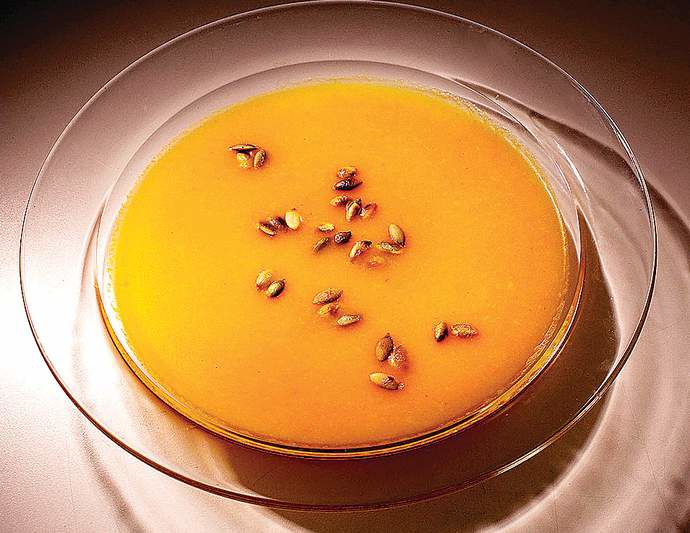When the cook’s ill but not ill-prepared
Published 4:00 am Tuesday, January 11, 2011

- The kick of ginger will be appreciated by anyone who’s under the weather.
Years ago, when I lived in Boston, the answer to one question would determine whether I would drag myself in to work on days when I felt under the weather: Would my friend Chin accompany me to eat pho ga on our lunch hour? Nothing seemed to heal like that steaming bowl of rich chicken broth packed with rice noodles and clean strips of chicken breast, especially once I dropped in the basil and bean sprouts and squeezed in fresh lime juice and Sriracha.
These days, the best pho around isn’t within walking distance of my workplace (although it’s getting closer), so my favorite cold-recovery soups are the ones I make myself. And I’m not talking about pho, which requires more time and effort than I want to spend when I’m fighting a cold and losing.
When I got bitten by a nasty bug late last year, I might have attempted a reasonable facsimile of pho if homemade chicken broth had been waiting in my freezer, as is sometimes the case; instead, I had to look elsewhere in my fridge and pantry and improvise.
I have several criteria for soups to make for myself (and take to work for lunch) when all I really want to do is stay in bed: They need to contain some of my favorite make-me-feel-better ingredients; they need to be pungently flavored to get past my compromised sense of taste; and I should be able to put them together mostly, if not entirely, with things I have around. Although I love to make Mediterranean-leaning soup bases out of beans or potatoes, when I’ve got a cold I crave lighter approaches.
Recently, all those criteria converged pretty neatly and pointed me toward Japan, not Vietnam or Italy, for inspiration.
It’s not the first time. For years, whenever I’ve felt something coming on, I have made and guzzled a fresh Japanese ginger tea suggested to me by my friend Deb Samuels, a cookbook author. That’s how I’ve grown addicted to the seemingly miraculous curative abilities of ginger, which I always have on hand. I’m also a devotee of dashi, the traditional Japanese broth made from seaweed and bonito flakes, which made the perfect base for a carrot-ginger soup I put together as a first course for this year’s Thanksgiving dinner. Scaled down to three or four servings, the soup has become a main course for me when I want a dose of vitamin C and that spicy kick of ginger. I remove the seaweed after it infuses water with flavor for the dashi, and I chop it up and add it to a side salad.
Like the seaweed and bonito, the ingredients in my other new go-to cold-season soup are shelf-stable, meaning I can pull together a flavorful broth without the need for simmering bones and aromatic vegetables. Mushroom powder, which I previously had used only for Italian cooking, easily makes the leap to another Japanese-inspired soup of mushrooms and buckwheat soba noodles. Antioxidant-rich mushrooms go in fresh, of course, and the powder (which you can easily make by grinding dried porcini, shiitake or other varieties) bulks up the background flavor as well, giving the soup a double punch of earthiness.
It’s just what I need when I’m sick. Making it doesn’t tire me out, and the flavors are bold enough to actually taste. Eating it leaves me feeling — if only for a few minutes — ready for the rest of the workday.
Double Mushroom Soup With Soba Noodles
Makes 3 or 4 servings.
6 C water
4 oz dried buckwheat soba noodles
1 TBS toasted sesame oil
8 oz cremini mushrooms, briefly rinsed, stemmed and cut into 1⁄2-inch pieces
4 whole scallions, trimmed and cut on the diagonal into 1⁄4-inch slices
Sea salt
1 TBS porcini powder
Bring the water to a boil in a large saucepan over high heat. Add the soba noodles; reduce the heat to medium or medium-low to maintain a low boil. Cook for about 5 minutes, until the noodles are just starting to become tender but still have a slight bite, stirring occasionally to prevent them from clumping.
Meanwhile, heat the oil in a large skillet over medium heat until the oil shimmers. Add the mushrooms and half of the scallions; cook until the mushrooms have exuded their juices and have started to become tender, about 4 minutes. Add salt to taste. Remove from the heat.
When the soba noodles are tender, whisk in the porcini powder and add the mushroom mixture, including any liquid in the skillet. Cook, with the liquid gently bubbling, for 2 or 3 minutes to make sure the porcini powder has dissolved and the mushrooms are heated through.
Remove from the heat, add salt to taste, then ladle out a single portion. Sprinkle the remaining scallions on top, and eat.
The remaining portions can be refrigerated in an airtight container for up to a week. Freezing the soup is not recommended, as it will make the soba noodles mushy.
Ginger-Packed Carrot Soup
Makes 3 or 4 servings.
This soup starts with a quick version of dashi, a Japanese broth made from seaweed and bonito flakes. You can substitute vegetable broth.
4 strips wakame seaweed, such as Eden brand
6 C cold water
1⁄2 C lightly packed bonito flakes, such as Eden brand
1 TBS extra-virgin olive oil
1 sm yellow onion, chopped (about 1 C)
1 3-inch piece peeled ginger root, finely chopped or grated (about 2 TBS)
1 lb carrots, trimmed and coarsely grated
1 to 2 tsp unseasoned rice vinegar (may substitute white vinegar)
Sea salt
1⁄4 C roasted pumpkin seeds, or raw unsalted pumpkin seeds, roasted
Combine the seaweed and water in a large saucepan; bring to a boil over high heat. Use tongs to immediately fish out the seaweed, holding it over the pan to let the excess liquid drip off, and transfer it to a bowl. Let dry and reserve for another use.
Add the bonito flakes to the liquid in the saucepan; remove the pan from the heat. Let the mixture steep, creating a broth, until the flakes sink to the bottom, then pour it through a fine-mesh strainer into a bowl, pressing on the bonito flakes to extract as much liquid as possible. Discard the bonito flakes. Rinse and dry the saucepan.
Heat the oil in the same saucepan over medium-high heat until the oil starts to shimmer. Add the onion and ginger; cook for about 3 minutes, stirring occasionally, until the onion starts to soften. Stir in the carrots and strained broth; bring to a boil, then reduce the heat to medium, cover and cook until the carrots are tender, about 12 minutes.
Use an immersion (stick) blender to puree to form a smooth soup. (Alternatively, transfer to a blender and puree, making sure to remove the center knob in the lid and holding a dish towel over it to avoid splattering, then return to the saucepan to keep warm.) Add the rice vinegar and salt to taste.
Ladle out enough for one portion and garnish with a tablespoon of the toasted pumpkin seeds. Reserve the remaining seeds for other servings of soup.
Divide the remaining soup among three freezer-safe containers. Cool, then freeze for up to several months, or refrigerate for up to a week.






